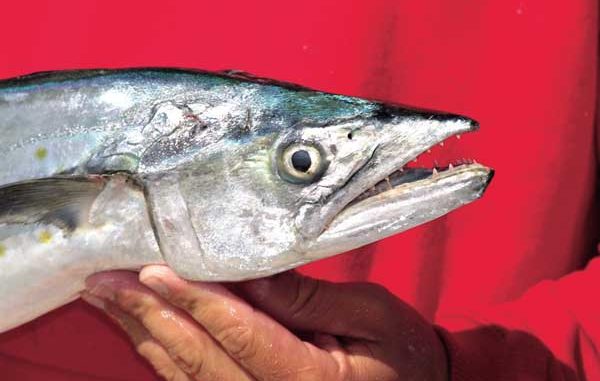
‘Buoyed’ by markers, Edisto anglers can take the easy path to mackerel heaven.
For some anglers, fishing for Spanish mackerel is a poor man’s deep-sea trip. For others, Spanish are the ultimate for close-in, light-tackle fishing in the ocean.
Granted, they don’t produce the long, line-sizzling runs or have the jumping ability of the dolphin, but you don’t have to go to the Gulf Stream to find them, either. Most Spanish are caught from just beyond the breakers on out to a few miles off the beach.
Spanish mackerel are a gourmet’s delight when they are put on ice immediately after being pulled from the ocean. Filets broiled in butter with a touch of lemon juice melt in your mouth; deep-fat fried to a golden brown, dipped in shrimp cocktail sauce isn’t a bad meal either.
Before you eat them, however, you have to catch them. How do you locate Spanish and how do you fish for them when they are found? What type of tackle should be used, and what lures are most productive?
A favorite destination for fishermen targeting Spanish mackerel in their prime season — late spring — is Edisto Beach, where the makings of a great meal can begin with a boat trip down the South Edisto River toward St. Helena Sound.
From the mouth of the sound, it’s a matter of choosing whether to head straight out in the ocean or turn northward toward the mouth of the North Edisto River. Both spots can be productive on a regular basis, and finding Spanish mackerel can be a matter of trolling between buoys that mark the entrance to the sound from the ocean.
Fish can often be found around the “A” can buoy or at the STH buoy, which is roughly due south — from the “A” can. Cover the area just west of the STH buoy to the No. 2 red nun buoy; the area between these two buoys can be dynamite from time to time. On a course due south from the STH buoy is the 6HI buoy off Hunting Island. Not only will you find Spanish there, but king mackerel, barracuda and amberjack as well.
To fish points north of Edisto Beach, take a 100-degree course from the “A” can toward the buoy that marks the 4KI reef off Kiawah Island. Spanish have a habit of hanging out between 4KI and the red buoy that marks the entrance to the North Edisto River; that area is usually alive with Spanish in June and again in August.
Once you’re in an area that’s potentially productive, you can “blind troll” for fish or keep a sharp eye out for flocks of gulls and other sea birds picking at the surface or Spanish actually leaping clear of the water. A good set of binoculars is worth its weight in gold for this job, and each member of the fishing crew should keep a constant lookout.
“Blind trolling” is the way to go when no fish are feeding at the surface. You’re methodically pullling lures through the water, searching for fish. Trolling speed should be between 1,100 and 1,200 rpm. If your tachometer isn’t working — or your boat doesn’t have one — experiment by trolling a No. 0 Clark Spoon 50 feet behind the stern. Slowly increase your trolling speed until the spoon begins to skip on the surface; that’s the speed you need to troll.
Your favorite spinning or baitcasting tackle will work fine, with the reel spooled with 8- to 20-pound test line. Spanish mackerel have extremely sharp teeth; using a heavier leader will substantially lower the number of times you’re cut off, but they will also drastically lower the number of strikes you get. When trolling multiple rods, alternate the amount of line you have out on each outfit to reduce tangling.
Spanish mackerel won’t be the only predator stalking baitfish in May and June, but they can be easily identified. Spanish will swirl at baitfish on the surface, and you will actually see fish jumping clear of the water. Yellow spots on silver sides is a dead giveaway.
Bluefish slash at the surface but rarely jump clear of the water. Jack crevalle make a lot of noise feeding at the surface; you often hear them before you see them. Bonito make large splashes as they feed at the surface, but they are prone to be skittish, darting from one pod of baitfish to another. Occasionally, they clear the water, letting you see their football-shape and striped sides.
Spanish often feed under schools of baitfish and won’t come to the surface to take a lure. That’s when using downriggers or planers to get lures below the surface is necessary. The same rod-and-reel combos can be used when fishing with downriggers, but when trolling Nos. 1 and 2 planers, stiffer rods and heavier lines are required. Limit the length of line fished behind the planer so hooked Spanish can be more easily lifted over the gunwales.
Spanish will hit a variety of lures, including small trolling plugs, small bucktail jigs, crappie jigs, tube lures and shiny spoons. The No. 0 Clark Spoon is a favorite, along with a homemade tube lure made from a red-white-yellow striped McDonald’s soda straw.
When casting to Spanish feeding at the surface, stop your boat a comfortable cast away from schooling fish; do not drive into the middle of the school. A medium-fast to fast retrieve will produce the best results.
Spanish are prone to spit up bits and pieces of baitfish when brought onboard, and they’re also prone to bleeding a lot. Leaving a 30-gallon trash can in the middle of your boat — with several towels draped over the edges — will keep your boat much cleaner. As soon as you lift your fish over the gunwale, drop it into the trash can. Use a towel to grasp the fish as you lift it out of the can; the towel protects your fingers. Then, you can put the fish on ice in your cooler.
One trick that has saved many a day is to beat the water rapidly with your rod tip if Spanish are close to your boat but not striking. This simulates fish feeding at the surface and will often put Spanish back in a feeding mood.
King mackerel and barracuda are prevalent in many of the same waters off Edisto as Spanish mackerel. If Spanish aren’t feeding on the surface and trolling appears to be the way you’ll have to fish, you might want to put out a “meat line.”
Tie one end of a 60-foot length of 3/16th-inch nylon rope to a No. 5 planer and the other to a cleat on the transom. Tie 20 feet of 100-pound test mono to the planer and tie on a 6-inch Drone spoon. This rig will pick up king mackerel and barracuda that often travel under schools of Spanish.
Try to choose a calm day to target Spanish; smooth water lends itself to more productive trips. Gulls have outstanding eyesight and can spot feeding Spanish at unrealistic distances. Depend heavily on these eyes in the sky to show you where the Spanish are.

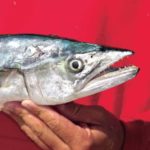
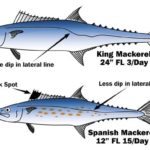
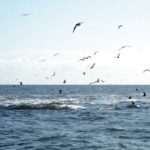
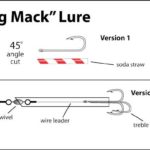
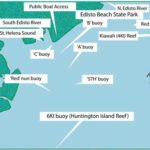
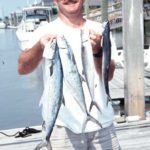


Be the first to comment